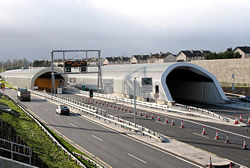Tunnels
| Tunnels | ||
 | ||
| The Dublin Port Tunnel in Ireland. | ||
| Pictures related to Tunnels View gallery (41) | ||
| Quick Links | ||
| Crossings: Bridges • Causeways • Ferries | ||
A tunnel is a structure carrying a route underground for a distance. A large majority of road tunnels are built under rivers and through hills, though some may be built to allow development above the road. In the UK, some tunnels are referred to as underpasses - there are no distinct rules as to naming conventions.
Types of Tunnel
Cut and Cover
The Cut and Cover tunnel is unusual, as it usually involves digging out an open trench in which the road is placed, and then is given a 'lid' afterwards to create the tunnel. These tunnels are often employed in urban contexts where a road is deemed obtrusive if left uncovered. The glaring exception to this design rule is the Weston Hills Tunnel which when built featured two distinct tubes which were then covered with earth when the hill above was reinstated.
Bored
The Bored tunnel is created by a Tunnel Boring Machine (TBM) and can be very costly, but it is the only feasible way to tunnel through solid rock and in most cases underneath riverbeds. In some instances bored tunnels are constructed underneath urban areas, for example the Brynglas Tunnels on the M4. The oldest road tunnel still in active use in the United Kingdom, the northbound Blackwall Tunnel on the A102 is of the bored type.
Immersed Tube
The Immersed Tube tunnel is a relatively recent method of tunnelling and as a result is still extremely costly but can be placed with relative ease underneath river estuaries. The tunnel is usually fabricated off site and then 'lowered' into a trench dredged in the water. The sections are linked together and pumped dry before the roadway is constructed and the tunnel fitted out.
List of all tunnels




